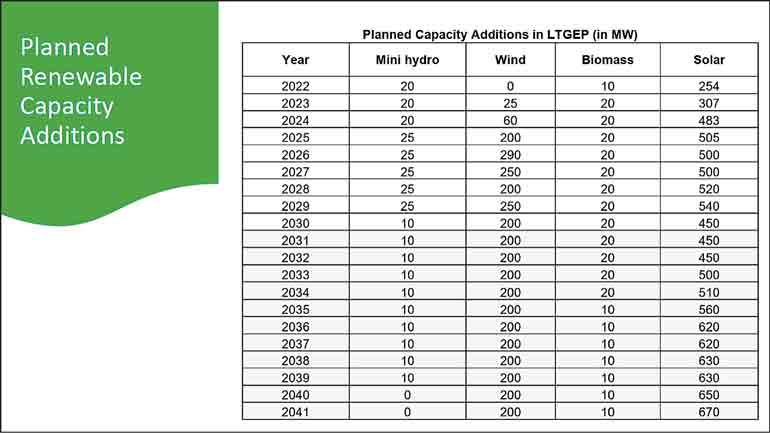Monday Mar 03, 2025
Monday Mar 03, 2025
Thursday, 19 September 2024 00:20 - - {{hitsCtrl.values.hits}}

 Sri Lanka stands at crucial crossroads. With an increasing reliance on imported fossil fuels, amidst global climate challenges and energy security concerns, the nation faces mounting economic and environmental pressures.
Sri Lanka stands at crucial crossroads. With an increasing reliance on imported fossil fuels, amidst global climate challenges and energy security concerns, the nation faces mounting economic and environmental pressures.
However, the island nation, blessed with abundant natural resources presents a unique opportunity to transition to a more sustainable energy future. The narrative surrounding renewable energy, is gaining traction, not only as a necessity but as a vision for a self-reliant and prosperous Sri Lanka.
Return to roots
In the past, Sri Lanka’s energy infrastructure was predominantly renewable. In the mid-1980s, the country met approximately 80% of its energy requirements using domestic renewable resources, such as hydro and biomass. Only 20% of the energy, primarily for transportation and minor needs, was sourced from imported fossil fuels. It enabled Sri Lanka to be largely self-sufficient in energy production, relying on its own renewable resources for the bulk of its energy needs.
However, over the years, population growth, industrialisation, and increased energy demands have shifted this balance, with fossil fuels now accounting for over 51% of the country’s energy mix, leading to a higher dependency creating economic and environmental challenges. The need to move away from fossil fuels towards renewable energy is not only a national priority but also a global imperative.
Urgency of change
The recent economic crisis in Sri Lanka starkly highlighted the vulnerabilities of depending heavily on imported fossil fuels. Power cuts lasting up to 13 hours, fuel shortages and the inability to afford fossil fuel imports because of limited foreign exchange, not only disrupted daily life, but also demonstrated the critical need for energy independence.
It is clear that Sri Lanka cannot continue on this path. The country must shift towards harnessing its indigenous renewable resources, such as solar, wind and biomass, to meet its growing energy needs. While efforts are ongoing to explore possible petroleum reserves, the focus must remain on renewable energy, as this is the only viable and sustainable option moving forward.
Political consensus
Today, with Presidential elections imminent, the importance of renewable energy has gathered support across the political spectrum. This realisation has been acknowledged by all major political leaders – Ranil Wickremesinghe, Sajith Premadasa, and Anura Kumara Dissanayake – have included strong commitments and renewable energy targets into their manifestos.
n Ranil Wickremesinghe aims to achieve 70% renewable energy by 2030, making Sri Lanka a Green Energy hub and exporting to neighbouring countries. The plan includes developing Trincomalee and Pooneryn as energy hubs, reducing energy costs, and implementing climate-friendly policies across key sectors.
n Sajith Premadasa’s Samagi Jana Balawegaya (SJB) emphasises climate action through a National Adaptation Plan (NAP) focused on renewable energy. According to the manifesto, the aim is to exceed the 70% renewable energy target by 2030, positioning Sri Lanka as a regional renewable energy powerhouse.
n Anura Kumara Dissanayake’s manifesto emphasises the potential of wind power, stating, the nation has the capability to harness over 40 gigawatts of wind power and sees renewable energy as a pathway to enter the global energy market.
Like many countries globally, Sri Lanka is on the cusp of an energy transition from fossil fuels to renewables, and the future of the nation’s energy sector will largely depend on this shift.
Solar and Wind power potential
Sri Lanka’s renewable energy resources are diverse, with a focus on hydro, solar, and wind. Being close to the equator, the country benefits from abundant sunlight, making solar energy widely available. Surrounded by the sea, Sri Lanka also has excellent onshore and offshore wind potential. While resources such as geothermal and wave energy exist, they are not commercially viable yet. As the country’s hydro resources are nearly fully utilised, the focus is now shifting primarily to expanding solar and wind energy.
As of 31 March 2024, Sri Lanka’s total installed generation capacity was 5,012 MW. Excluding hydro, renewable energy sources contributed only 1,093 MW, which is about a fifth of the total installed capacity. The long-term generation expansion plan aligns with the government’s commitment to achieve 70% renewable energy by 2030 and carbon neutrality by 2050. The plan emphasises mini-hydro, wind, biomass, and solar technologies, all renewable in nature.
According to a joint study conducted by the United Nations Development Program and the Asian Development Bank, Sri Lanka houses a potential of 16 GW solar power . World Bank estimates Sri Lanka’s offshore wind potential is 92 GW . With limited scope of adding large scale hydro projects in the future, it is the wind and solar projects which will have to do the heavy lifting for SL to meet its renewable energy generation goals.
Over the next 25 years, the country’s power demand is projected to grow at an annualised rate of ~5% and SL will need to add ~7,000 MW of fresh renewable energy, mainly consisting of ~4,700 MW of solar and ~1,800 MW of wind power .
The growth in solar capacity, particularly rooftop installations, which is crucial for decentralised energy generation reflects a positive trend towards renewable energy adoption. The total solar capacity in Sri Lanka has shown a steady increase from 1.36 MW in 2011 to 951.36 MW in 2023. The net metering achievements indicate a supportive regulatory framework that encourages individual and commercial investments in solar energy.
The substantial wind resource suggests that Sri Lanka has a significant potential for harnessing a vast untapped capacity of wind energy, particularly contributing to reducing reliance on imported fossil fuels and enhancing energy security.
Both solar and wind power data indicate a strong potential for renewable energy development in Sri Lanka. The significant solar capacity available, combined with the rapid growth wind resource positions the country to enhance its energy independence, reduce greenhouse gas emissions, and meet future energy demands sustainably.
Economic and environmental benefits
Investing in renewable energy will have far-reaching, multifaceted economic and environmental benefits for Sri Lanka including job creation and reduced energy costs. In addition, multilateral and bilateral agencies now prioritise funding for renewable projects over fossil fuel-based ones. The global shift highlights the financial and environmental advantages of adopting renewable energy offering Sri Lanka a competitive edge in global markets.
In the solar industry alone, over 900 companies have already been established to service the growing demand. Similarly, wind power projects are expected to generate thousands of jobs as the country ramps up capacity. These expansions will require substantial manpower, creating numerous local jobs during both the construction and operational phases of projects.
A reduction in overall energy costs for households and industries is predicted, making Sri Lanka more competitive in attracting energy-intensive industries. Lower energy costs will also benefit households and contribute to a more robust economy.
Renewable energy is not just about addressing Sri Lanka’s current energy crisis but also about shaping the country’s long-term sustainability goals. Sri Lanka, having committed to reducing carbon emissions under the Paris Agreement, aims for net-zero carbon emissions by 2050, and renewable energy will be crucial to achieving this goal, offering a much lower environmental impact compared to coal or other fossil fuels.
The nation can lead by example in the global fight against climate change. Moreover, the cost of renewable energy technologies has decreased dramatically, making them sustainable. These shifts will help mitigate the effects of climate change, and reduce pollution, leading to healthier communities and ecosystems.
Priorities for the ‘Next Government’
To ensure the success of Sri Lanka’s renewable energy transition, the next Government must prioritise several key areas. First, grid infrastructure must be enhanced to accommodate intermittent energy sources such as wind and solar. Second, regulatory frameworks need to be streamlined to expedite the approval process for renewable energy projects. Finally, the Government should create partnerships with international and local investors to finance large-scale renewable energy developments.
Sri Lanka stands at the threshold of a renewable energy revolution. Solar and wind power, with its vast potential, offers a pathway to energy independence, economic growth, and environmental sustainability and also an opportunity to become a regional leader in green energy production.
As the country moves forward, it must continue to invest in renewable energy technologies, infrastructure, and policies that will ensure a secure and sustainable energy future for generations to come.
https://www.adb.org/sites/default/files/publication/354591/sri-lanka-power-2050v2.pdf
https://documents1.worldbank.org/curated/en/828731586850081077/pdf/Technical-Potential-for-Offshore-Wind-in-Sri-Lanka-Map.pdf
https://www.themorning.lk/articles/C2a9RM0BiUCA40tviZfS
(The writer is a Professor in Electrical Engineering attached to the Department of Electrical Engineering at the University of Moratuwa, Sri Lanka.)
Discover Kapruka, the leading online shopping platform in Sri Lanka, where you can conveniently send Gifts and Flowers to your loved ones for any event including Valentine ’s Day. Explore a wide range of popular Shopping Categories on Kapruka, including Toys, Groceries, Electronics, Birthday Cakes, Fruits, Chocolates, Flower Bouquets, Clothing, Watches, Lingerie, Gift Sets and Jewellery. Also if you’re interested in selling with Kapruka, Partner Central by Kapruka is the best solution to start with. Moreover, through Kapruka Global Shop, you can also enjoy the convenience of purchasing products from renowned platforms like Amazon and eBay and have them delivered to Sri Lanka.
Discover Kapruka, the leading online shopping platform in Sri Lanka, where you can conveniently send Gifts and Flowers to your loved ones for any event including Valentine ’s Day. Explore a wide range of popular Shopping Categories on Kapruka, including Toys, Groceries, Electronics, Birthday Cakes, Fruits, Chocolates, Flower Bouquets, Clothing, Watches, Lingerie, Gift Sets and Jewellery. Also if you’re interested in selling with Kapruka, Partner Central by Kapruka is the best solution to start with. Moreover, through Kapruka Global Shop, you can also enjoy the convenience of purchasing products from renowned platforms like Amazon and eBay and have them delivered to Sri Lanka.